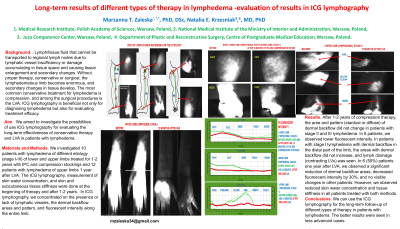Clinical Research
(CR-066) Long-term results of different types of therapy in lymphedema -evaluation of results in ICG lymphography

Lymph/tissue fluid that cannot be transported to regional lymph nodes due to lymphatic vessel insufficiency or damage accumulating in tissue space and causing tissue enlargement and secondary changes. Without proper therapy, conservative or surgical, the lymphedematous limb becomes enormous, and secondary changes in tissue develop. The most common conservative treatment for lymphedema is compression, and among the surgical procedures is the LVA. ICG lymphography is beneficial not only for diagnosing lymphedema but also for evaluating treatment efficacy.
We aimed to investigate the possibilities of using ICG lymphography to evaluate the long-term effectiveness of conservative therapy and LVA in patients with lymphedema.
Methods: . We investigated ten patients with lymphedema of different etiology (stage I-III) of lower and upper limbs treated for 1-2 years with IPC and compression stockings and 12 patients with lymphedema of upper limbs one year after LVA. The ICG lymphography, measurement of skin water concentration, and skin and subcutaneous tissue stiffness were done at the beginning of therapy and after 1-2 years. In ICG lymphography, we concentrated on the presence or lack of lymphatic vessels, the dermal backflow areas and pattern, and fluorescent intensity along the entire limb.
Results:
After 1-2 years of compression therapy, the area and pattern (stardust or diffuse) of dermal backflow did not change in patients with stage II and III lymphedema. In 6 patients, we observed lower fluorescent intensity. In patients with stage I lymphedema with dermal backflow in the distal part of the limbs and visible lymph drainage to the inguinal LNs, the areas with dermal backflow did not increase, and the lymph drainage (contracting LVs) was seen. In 6 (50%) patients one year after LVA, we observed a significant reduction of dermal backflow areas, decreased fluorescent intensity by 30%, and no visible changes in other patients. However, we observed reduced skin water concentration and tissue stiffness in all patients treated with both methods.
Discussion:
Conclusion. We can use the ICG lymphography for the long-term follow-up of different types of therapy in patients with lymphedema. The better results were seen in less advanced cases.

.jpeg)